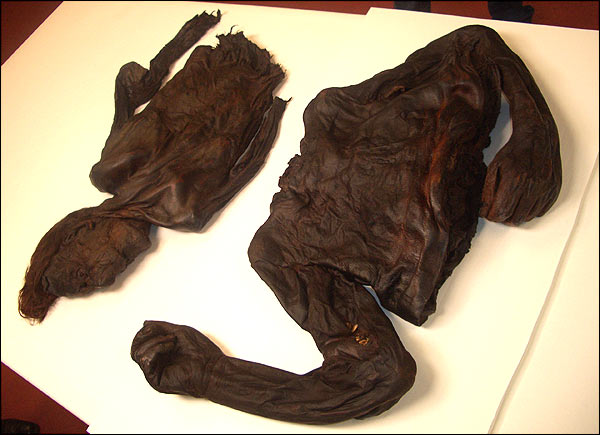DEGRADING THE DEAD?
Phlllp Hensher (presumably this is meant to be author Phillip Hensher) writes in the Sunday Tribune today about displaying the dead. In a meandering and ill-thought out piece (imho) he criticises the unveiling of Tutankhamun’s body and rails at the ‘recent’ habit of displaying the bodies of ‘unremarkable’ people. By ‘unremarkable’ he seems to mean people who are remarkable for neither great wickedness nor great virtue.
The article, I’m assuming, is a syndicated one, and Phillip seems to imply that ‘we’ (and here we have to assume Western Europeans) are not as ‘robust’ in our attitude to the dead, that it’s peculiar to the culture that has produced ‘this obscene display’.
There are, in fact numerous places throughout the world, most of them religious, but also many museums, including the British museum and the National Museum of Ireland where the dead are displayed in one way or another. Some are as a result of mummification such as our own bog bodies*, the burials in St. Michan’s, Tollund man in Denmark and Lindow Man in London (not forgetting Jerdacuttup Man – also the title of an excellent Triffids song from their album ‘Calenture’), others artistic arrangements of bones and skulls, and in other cases preserved Saints (or parts of them – witness Saint Therese of Lisieux‘s recent tour of Ireland).

Above – Croghan Man (Image, NMI)
Notwithstanding the fact that King Tut was, by all accounts, a fairly ‘unremarkable’ ruler, the circumstances of his excavation and the resulting curse myth, make his body a remarkable museum display. His ‘tour’ is not a selfish act on the part of the Egyptian authorities, predicated on encouraging tourists to visit and spend money in Egypt – and even if it is, where’s the harm in that? Ancient Egypt was an amazing and fascinating culture, and Tutankhamun is perhaps the most famous dead person in the world. For Hensher to conclude that the display of King Tut is against all propriety and decency is stretching his point a little.
There is nothing new about museums displaying human remains, and existing collections are longstanding and extensive. And yes, the appropriateness of the display of the dead can sometimes be considered questionable. However (someone once told me never to start a sentence with ‘however’) the study and presentation of our past necessitates it, and especially if it is carried out in a respectful way which is also an educational experience. Different people have different feelings about human remains and modern museum practitioners recognize this. Visitor surveys in the UK, however, have demonstrated that most museum-goers are perfectly comfortable with, and more often than not, expect to see, displays of the dead. Human remains are generally only displayed when those remains make a material contribution to the interpretation of the dead, and as I’m sure is the case with King Tut, are accompanied by sufficient explanatory material. For those who have no wish to see them there is the option of not going. An encounter with the dead in a museum is, for many people, their first exposure to death outside of their immediate family or friends, and, in most cases is not ‘obscene’. In my opinion, it’s actually a positive experience, which re-humanizes our dead and provides us with an opportunity to reflect, is in itself an act of respect and gives us an opportunity to get to know ourselves better.
*Below is a piece about one example – Cloneycavan man – from Melanie Giles excellent ‘BOG BODIES: REPRESENTING THE DEAD’ available in full at this link. Melanie’s paper also addresses the ethics of presenting the dead in a far more articulate way than I could (Dec).
Cloneycavan Man was found on a peat conveyor belt, the body consisted of an upper torso but with head intact. The date of death was around 392-201 BC. Though not well preserved (possibly due to his death in summer, but mainly due to its removal and damage by the excavator), it is evident that this individual was around 5 ft 2″ in height. An elaborate top-knot hairstyle, kept in place by a plant-based oil mixed with pine resin from France or Spain, has been interpreted as an attempt to create an impression of height, but it may also have been part of the ritual preparation of the body before death. (A number of the Continental bog bodies have either had their hair cut or partly shaved shortly before death). Cloneycavan Man had received three shattering blows to the skull, before being disembowelled with a deep knife-cut.
ADDENDUM: 12/11/2007 – Just tracked down Phillip Hensher’s original piece on the English Independent‘s online site – it was obviously edited down for the ST and makes a little more sense in the original. Still disagree with him though.
This entry was posted on Sunday, November 11th, 2007 at 7:56 pm. It is filed under About Archaeology, About Moore Group and tagged with About Archaeology, bog bodies, Cloneycavan man, croghan man, Egypt, environmental consultants galway, Jerdacuttup man, Museums, Phillip Hensher, sunday tribune, the dead, The triffids, tutankhamen, tutankhamun.
You can follow any responses to this entry through the RSS 2.0 feed.




Yes, displaying the dead does bother quite a lot of folks, one I don’t personally find problematic – difficult to accomodate varying attitudes to death.